Deck 15: Introduction to the Analysis of Variance
سؤال
سؤال
سؤال
سؤال
سؤال
سؤال
سؤال
سؤال
سؤال
سؤال
سؤال
سؤال
سؤال
سؤال
سؤال
سؤال
سؤال
سؤال
سؤال
سؤال
سؤال
سؤال
سؤال
سؤال
سؤال
سؤال
سؤال
سؤال
سؤال
سؤال
سؤال
سؤال
سؤال
سؤال
سؤال
سؤال
سؤال
سؤال
سؤال
سؤال
سؤال
سؤال
سؤال
سؤال
سؤال
سؤال
سؤال
سؤال
سؤال
سؤال
سؤال
سؤال
سؤال
سؤال
سؤال
سؤال
سؤال
سؤال
سؤال
سؤال
سؤال
سؤال
سؤال
سؤال
سؤال
سؤال
سؤال
سؤال
سؤال
سؤال
سؤال
سؤال
سؤال
سؤال
سؤال
سؤال
سؤال
سؤال
سؤال
سؤال

فتح الحزمة
قم بالتسجيل لفتح البطاقات في هذه المجموعة!
Unlock Deck
Unlock Deck
1/218
العب
ملء الشاشة (f)
Deck 15: Introduction to the Analysis of Variance
1
The alternative hypothesis evaluated by F obt in the one-way ANOVA states that _________.
A) all conditions have the same effect
B) one or more of the conditions have different effects
C) µ 1 = µ 2 = u 3 = µ k
D) µ 1 ≠ µ 2 ≠ µ 3 ≠ µ k
E) b and d
A) all conditions have the same effect
B) one or more of the conditions have different effects
C) µ 1 = µ 2 = u 3 = µ k
D) µ 1 ≠ µ 2 ≠ µ 3 ≠ µ k
E) b and d
one or more of the conditions have different effects
2
As the differences between the group means increases, _________.
A) MSbetween increases
B) F obt decreases
C) t obt decreases
D) all of these
E) none of the above
A) MSbetween increases
B) F obt decreases
C) t obt decreases
D) all of these
E) none of the above
MSbetween increases
3
Which of the following is(are) true?
A) df for MSwithin = N - k
B) df for MSbetween = k - 1
C) df total = N - 1
D) all of these
A) df for MSwithin = N - k
B) df for MSbetween = k - 1
C) df total = N - 1
D) all of these
all of these
4
The null hypothesis in the one-way ANOVA asserts that _________.
A) the within groups variance estimate is an estimate of the population variance
B) µ 1 = µ 2 = µ 3 = µ k
C) the between group variance estimate and the within group variance estimate are both estimates of the same population variance
D) the within group sum of squares is equal to the between group sum of squares
E) µ 1 = µ 2 = µ 3 = µ k and the between group variance estimate and the within group variance estimate are both estimates of the same population variance
A) the within groups variance estimate is an estimate of the population variance
B) µ 1 = µ 2 = µ 3 = µ k
C) the between group variance estimate and the within group variance estimate are both estimates of the same population variance
D) the within group sum of squares is equal to the between group sum of squares
E) µ 1 = µ 2 = µ 3 = µ k and the between group variance estimate and the within group variance estimate are both estimates of the same population variance

فتح الحزمة
افتح القفل للوصول البطاقات البالغ عددها 218 في هذه المجموعة.
فتح الحزمة
k this deck
5
The one-way ANOVA partitions the total variability into _________.
A) ΣSwithin and ΣS between
B) MSwithin and MSbetween
C) ΣSwithin and ΣS total
D) ΣS between and MSbetween
A) ΣSwithin and ΣS between
B) MSwithin and MSbetween
C) ΣSwithin and ΣS total
D) ΣS between and MSbetween

فتح الحزمة
افتح القفل للوصول البطاقات البالغ عددها 218 في هذه المجموعة.
فتح الحزمة
k this deck
6
An investigator conducts an experiment involving the effects of three levels of a drug on memory. Subjects are randomly assigned to one of three conditions. A different drug level is administered in each condition. Memory is measured 10 minutes after each subject receives the drug. The following scores are recorded. The higher the score, the better the memory.  MSbetween = _________.
MSbetween = _________.
A) 48.250
B) 50.145
C) 51.254
D) 45.750
 MSbetween = _________.
MSbetween = _________.A) 48.250
B) 50.145
C) 51.254
D) 45.750

فتح الحزمة
افتح القفل للوصول البطاقات البالغ عددها 218 في هذه المجموعة.
فتح الحزمة
k this deck
7
Which of the following is (are) assumption(s) underlying the use of the F test?
A) the raw score populations are normally distributed
B) the variances of the raw score populations are the same
C) the mean of the populations differ
D) the raw score populations are normally distributed and the variances of the raw score populations are the same
E) all of these
A) the raw score populations are normally distributed
B) the variances of the raw score populations are the same
C) the mean of the populations differ
D) the raw score populations are normally distributed and the variances of the raw score populations are the same
E) all of these

فتح الحزمة
افتح القفل للوصول البطاقات البالغ عددها 218 في هذه المجموعة.
فتح الحزمة
k this deck
8
If df between = 2 and df within = 14, using a = 0.05, F crit = _________.
A) 19.42
B) 4.60
C) 3.74
D) 6.51
A) 19.42
B) 4.60
C) 3.74
D) 6.51

فتح الحزمة
افتح القفل للوصول البطاقات البالغ عددها 218 في هذه المجموعة.
فتح الحزمة
k this deck
9
The F ratio increases as _________.
A) the variability between means increases relative to the variability within groups
B) the variability between means decreases relative to the variability within groups
C) the total variability increases
D) the total variability decreases
E) the variability within groups remains the same
A) the variability between means increases relative to the variability within groups
B) the variability between means decreases relative to the variability within groups
C) the total variability increases
D) the total variability decreases
E) the variability within groups remains the same

فتح الحزمة
افتح القفل للوصول البطاقات البالغ عددها 218 في هذه المجموعة.
فتح الحزمة
k this deck
10
If its assumptions are met, the analysis of variance technique is appropriate when _________.
A) two or more factors are varied
B) several levels of a single independent variable are compared
C) three or more groups are involved
D) all of these
A) two or more factors are varied
B) several levels of a single independent variable are compared
C) three or more groups are involved
D) all of these

فتح الحزمة
افتح القفل للوصول البطاقات البالغ عددها 218 في هذه المجموعة.
فتح الحزمة
k this deck
11
Which of the following increase(s) as the difference between the group means increases?
A) MS between
B) F obt
C) t obt
D) all of these
A) MS between
B) F obt
C) t obt
D) all of these

فتح الحزمة
افتح القفل للوصول البطاقات البالغ عددها 218 في هذه المجموعة.
فتح الحزمة
k this deck
12
An investigator conducts an experiment involving the effects of three levels of a drug on memory. Subjects are randomly assigned to one of three conditions. A different drug level is administered in each condition. Memory is measured 10 minutes after each subject receives the drug. The following scores are recorded. The higher the score, the better the memory. 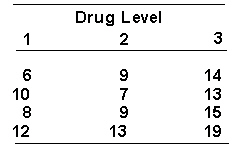 ΣSwithin = _________.
ΣSwithin = _________.
A) 62.25
B) 59.75
C) 56.65
D) 57.00
 ΣSwithin = _________.
ΣSwithin = _________.A) 62.25
B) 59.75
C) 56.65
D) 57.00

فتح الحزمة
افتح القفل للوصول البطاقات البالغ عددها 218 في هذه المجموعة.
فتح الحزمة
k this deck
13
The parameter being estimated in the analysis of variance is the ________.
A) sample mean
B) variance of the H 0 populations
C) sample variance
D) mean of the H 0 populations
E) F obt
A) sample mean
B) variance of the H 0 populations
C) sample variance
D) mean of the H 0 populations
E) F obt

فتح الحزمة
افتح القفل للوصول البطاقات البالغ عددها 218 في هذه المجموعة.
فتح الحزمة
k this deck
14
An investigator conducts an experiment involving the effects of three levels of a drug on memory. Subjects are randomly assigned to one of three conditions. A different drug level is administered in each condition. Memory is measured 10 minutes after each subject receives the drug. The following scores are recorded. The higher the score, the better the memory.  ΣS between = _________.
ΣS between = _________.
A) 94.2
B) 96.0
C) 96.5
D) 97.4
 ΣS between = _________.
ΣS between = _________.A) 94.2
B) 96.0
C) 96.5
D) 97.4

فتح الحزمة
افتح القفل للوصول البطاقات البالغ عددها 218 في هذه المجموعة.
فتح الحزمة
k this deck
15
An investigator conducts an experiment involving the effects of three levels of a drug on memory. Subjects are randomly assigned to one of three conditions. A different drug level is administered in each condition. Memory is measured 10 minutes after each subject receives the drug. The following scores are recorded. The higher the score, the better the memory.  MSwithin = _________.
MSwithin = _________.
A) 6.813
B) 6.558
C) 6.702
D) 6.639
 MSwithin = _________.
MSwithin = _________.A) 6.813
B) 6.558
C) 6.702
D) 6.639

فتح الحزمة
افتح القفل للوصول البطاقات البالغ عددها 218 في هذه المجموعة.
فتح الحزمة
k this deck
16
A major limitation of a two group design is that _________.
A) we can't run enough subjects
B) very often, two groups are insufficient for a clear interpretation
C) the population parameters may not be applicable
D) the means between groups may not differ
A) we can't run enough subjects
B) very often, two groups are insufficient for a clear interpretation
C) the population parameters may not be applicable
D) the means between groups may not differ

فتح الحزمة
افتح القفل للوصول البطاقات البالغ عددها 218 في هذه المجموعة.
فتح الحزمة
k this deck
17
Which of the following would cause F obt to increase?
A) an increase in the difference between the means
B) an increase in the within-groups variability
C) an increase in the magnitude of the independent variable's effect
D) an increase in the difference between the means and an increase in the within-groups variability
E) an increase in the difference between the means and an increase in the magnitude of the independent variable's effect
A) an increase in the difference between the means
B) an increase in the within-groups variability
C) an increase in the magnitude of the independent variable's effect
D) an increase in the difference between the means and an increase in the within-groups variability
E) an increase in the difference between the means and an increase in the magnitude of the independent variable's effect

فتح الحزمة
افتح القفل للوصول البطاقات البالغ عددها 218 في هذه المجموعة.
فتح الحزمة
k this deck
18
MSbetween is a measure of _________.
A) s 2 alone
B) s 2 + the effects of the independent variable
C) the variability between the means
D) b and c
A) s 2 alone
B) s 2 + the effects of the independent variable
C) the variability between the means
D) b and c

فتح الحزمة
افتح القفل للوصول البطاقات البالغ عددها 218 في هذه المجموعة.
فتح الحزمة
k this deck
19
If ΣStotal = 20 and ΣS between = 14, ΣSwithin = _________.
A) 34
B) 6
C) - 6
D) need more information
A) 34
B) 6
C) - 6
D) need more information

فتح الحزمة
افتح القفل للوصول البطاقات البالغ عددها 218 في هذه المجموعة.
فتح الحزمة
k this deck
20
When analyzing data from experiments that involve more than two groups _________.
A) doing t tests on all possible pairs of means decreases the probability of making Type I errors
B) doing t tests on all possible pairs of means increases the probability of making Type I errors
C) it is generally permissible to do t tests between all possible pairs of means and use Student's t distribution
D) doing t tests on all possible pairs of means increases the probability of making Type II errors
A) doing t tests on all possible pairs of means decreases the probability of making Type I errors
B) doing t tests on all possible pairs of means increases the probability of making Type I errors
C) it is generally permissible to do t tests between all possible pairs of means and use Student's t distribution
D) doing t tests on all possible pairs of means increases the probability of making Type II errors

فتح الحزمة
افتح القفل للوصول البطاقات البالغ عددها 218 في هذه المجموعة.
فتح الحزمة
k this deck
21
A clinical psychologist is interested in comparing the effectiveness of short term relaxation and cognitive-behavioral therapy in treating mild depression. An experiment is conducted in which 15 patients with mild depression are randomly selected and assigned 5 each to a relaxation therapy group, a cognitive/behavioral therapy group, and an attention placebo group. Therapy is administered until the patient is judged no longer depressed or until 10 treatment sessions have elapsed. The following data is obtained. Scores are the number of sessions for each patient.  F obt = _________.
F obt = _________.
A) 10.21
B) 8.44
C) 8.20
D) 6.88
 F obt = _________.
F obt = _________.A) 10.21
B) 8.44
C) 8.20
D) 6.88

فتح الحزمة
افتح القفل للوصول البطاقات البالغ عددها 218 في هذه المجموعة.
فتح الحزمة
k this deck
22
A clinical psychologist is interested in comparing the effectiveness of short term relaxation and cognitive-behavioral therapy in treating mild depression. An experiment is conducted in which 15 patients with mild depression are randomly selected and assigned 5 each to a relaxation therapy group, a cognitive/behavioral therapy group, and an attention placebo group. Therapy is administered until the patient is judged no longer depressed or until 10 treatment sessions have elapsed. The following data is obtained. Scores are the number of sessions for each patient.  MSbetween = _________.
MSbetween = _________.
A) 14.30
B) 13.76
C) 13.07
D) 11.84
 MSbetween = _________.
MSbetween = _________.A) 14.30
B) 13.76
C) 13.07
D) 11.84

فتح الحزمة
افتح القفل للوصول البطاقات البالغ عددها 218 في هذه المجموعة.
فتح الحزمة
k this deck
23
An investigator conducts an experiment involving the effects of three levels of a drug on memory. Subjects are randomly assigned to one of three conditions. A different drug level is administered in each condition. Memory is measured 10 minutes after each subject receives the drug. The following scores are recorded. The higher the score, the better the memory. 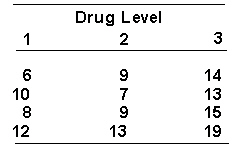 Using a = 0.05, what do you conclude?
Using a = 0.05, what do you conclude?
A) reject H 0 ; the drug has the same effect on memory at all levels
B) reject H 0 ; the drug does not have the same effect on memory at all levels
C) retain H 0 ; we cannot conclude that the drug affects memory
D) accept H 0 ; the drug has no effect on memory
 Using a = 0.05, what do you conclude?
Using a = 0.05, what do you conclude?A) reject H 0 ; the drug has the same effect on memory at all levels
B) reject H 0 ; the drug does not have the same effect on memory at all levels
C) retain H 0 ; we cannot conclude that the drug affects memory
D) accept H 0 ; the drug has no effect on memory

فتح الحزمة
افتح القفل للوصول البطاقات البالغ عددها 218 في هذه المجموعة.
فتح الحزمة
k this deck
24
Which of the following is(are) illegal values for F obt?
A) 1.00
B) 0.96
C) - 2.97
D) b and c
A) 1.00
B) 0.96
C) - 2.97
D) b and c

فتح الحزمة
افتح القفل للوصول البطاقات البالغ عددها 218 في هذه المجموعة.
فتح الحزمة
k this deck
25
What is the value of F crit for an experiment with k = 3, n 1 = n 2 = n 3 = 10 subjects, and a = 0.01?
A) 5.45
B) 4.51
C) 3.35
D) 5.49
A) 5.45
B) 4.51
C) 3.35
D) 5.49

فتح الحزمة
افتح القفل للوصول البطاقات البالغ عددها 218 في هذه المجموعة.
فتح الحزمة
k this deck
26
The total degrees of freedom for an experiment with n 1 = 10, n 2 = 12, and n 3 = 10 is ________.
A) 2
B) 32
C) 31
D) 29
A) 2
B) 32
C) 31
D) 29

فتح الحزمة
افتح القفل للوصول البطاقات البالغ عددها 218 في هذه المجموعة.
فتح الحزمة
k this deck
27
A clinical psychologist is interested in comparing the effectiveness of short term relaxation and cognitive-behavioral therapy in treating mild depression. An experiment is conducted in which 15 patients with mild depression are randomly selected and assigned 5 each to a relaxation therapy group, a cognitive/behavioral therapy group, and an attention placebo group. Therapy is administered until the patient is judged no longer depressed or until 10 treatment sessions have elapsed. The following data is obtained. Scores are the number of sessions for each patient.  SSwithin = _________.
SSwithin = _________.
A) 19.60
B) 16.80
C) 18.80
D) 22.80
 SSwithin = _________.
SSwithin = _________.A) 19.60
B) 16.80
C) 18.80
D) 22.80

فتح الحزمة
افتح القفل للوصول البطاقات البالغ عددها 218 في هذه المجموعة.
فتح الحزمة
k this deck
28
A clinical psychologist is interested in comparing the effectiveness of short term relaxation and cognitive-behavioral therapy in treating mild depression. An experiment is conducted in which 15 patients with mild depression are randomly selected and assigned 5 each to a relaxation therapy group, a cognitive/behavioral therapy group, and an attention placebo group. Therapy is administered until the patient is judged no longer depressed or until 10 treatment sessions have elapsed. The following data is obtained. Scores are the number of sessions for each patient.  Using a = 0.05, what do you conclude?
Using a = 0.05, what do you conclude?
A) reject H 0 ; there is no difference among the treatments
B) reject H 0 ; at least one of the treatments differs from at least one of the others
C) retain H 0 ; we cannot conclude that there is a difference among the treatments
D) accept H 0 ; we cannot conclude that there is a difference among the treatments
 Using a = 0.05, what do you conclude?
Using a = 0.05, what do you conclude?A) reject H 0 ; there is no difference among the treatments
B) reject H 0 ; at least one of the treatments differs from at least one of the others
C) retain H 0 ; we cannot conclude that there is a difference among the treatments
D) accept H 0 ; we cannot conclude that there is a difference among the treatments

فتح الحزمة
افتح القفل للوصول البطاقات البالغ عددها 218 في هذه المجموعة.
فتح الحزمة
k this deck
29
A clinical psychologist is interested in comparing the effectiveness of short term relaxation and cognitive-behavioral therapy in treating mild depression. An experiment is conducted in which 15 patients with mild depression are randomly selected and assigned 5 each to a relaxation therapy group, a cognitive/behavioral therapy group, and an attention placebo group. Therapy is administered until the patient is judged no longer depressed or until 10 treatment sessions have elapsed. The following data is obtained. Scores are the number of sessions for each patient.  Using a = 0.05, F crit = _________.
Using a = 0.05, F crit = _________.
A) 3.98
B) 19.41
C) 6.93
D) 3.88
 Using a = 0.05, F crit = _________.
Using a = 0.05, F crit = _________.A) 3.98
B) 19.41
C) 6.93
D) 3.88

فتح الحزمة
افتح القفل للوصول البطاقات البالغ عددها 218 في هذه المجموعة.
فتح الحزمة
k this deck
30
What is the value of F obt? 
A) 5.67
B) 6.53
C) 1.95
D) 3.26

A) 5.67
B) 6.53
C) 1.95
D) 3.26

فتح الحزمة
افتح القفل للوصول البطاقات البالغ عددها 218 في هذه المجموعة.
فتح الحزمة
k this deck
31
A clinical psychologist is interested in comparing the effectiveness of short term relaxation and cognitive-behavioral therapy in treating mild depression. An experiment is conducted in which 15 patients with mild depression are randomly selected and assigned 5 each to a relaxation therapy group, a cognitive/behavioral therapy group, and an attention placebo group. Therapy is administered until the patient is judged no longer depressed or until 10 treatment sessions have elapsed. The following data is obtained. Scores are the number of sessions for each patient.  Estimate the size of the effect. = _________
Estimate the size of the effect. = _________
A) 0.5226
B) 0.4824
C) 0.4393
D) 0.4658
 Estimate the size of the effect. = _________
Estimate the size of the effect. = _________A) 0.5226
B) 0.4824
C) 0.4393
D) 0.4658

فتح الحزمة
افتح القفل للوصول البطاقات البالغ عددها 218 في هذه المجموعة.
فتح الحزمة
k this deck
32
An investigator conducts an experiment involving the effects of three levels of a drug on memory. Subjects are randomly assigned to one of three conditions. A different drug level is administered in each condition. Memory is measured 10 minutes after each subject receives the drug. The following scores are recorded. The higher the score, the better the memory. 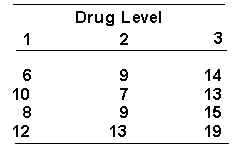 F obt = _________.
F obt = _________.
A) 8.31
B) 7.30
C) 7.27
D) 6.45
 F obt = _________.
F obt = _________.A) 8.31
B) 7.30
C) 7.27
D) 6.45

فتح الحزمة
افتح القفل للوصول البطاقات البالغ عددها 218 في هذه المجموعة.
فتح الحزمة
k this deck
33
A clinical psychologist is interested in comparing the effectiveness of short term relaxation and cognitive-behavioral therapy in treating mild depression. An experiment is conducted in which 15 patients with mild depression are randomly selected and assigned 5 each to a relaxation therapy group, a cognitive/behavioral therapy group, and an attention placebo group. Therapy is administered until the patient is judged no longer depressed or until 10 treatment sessions have elapsed. The following data is obtained. Scores are the number of sessions for each patient.  SS between = _________.
SS between = _________.
A) 27.53
B) 26.13
C) 23.67
D) 28.60
 SS between = _________.
SS between = _________.A) 27.53
B) 26.13
C) 23.67
D) 28.60

فتح الحزمة
افتح القفل للوصول البطاقات البالغ عددها 218 في هذه المجموعة.
فتح الحزمة
k this deck
34
What is your conclusion? Again use a = 0.05. 
A) retain H 0
B) reject H 1
C) reject H 0
D) accept H 0

A) retain H 0
B) reject H 1
C) reject H 0
D) accept H 0

فتح الحزمة
افتح القفل للوصول البطاقات البالغ عددها 218 في هذه المجموعة.
فتح الحزمة
k this deck
35
A clinical psychologist is interested in comparing the effectiveness of short term relaxation and cognitive-behavioral therapy in treating mild depression. An experiment is conducted in which 15 patients with mild depression are randomly selected and assigned 5 each to a relaxation therapy group, a cognitive/behavioral therapy group, and an attention placebo group. Therapy is administered until the patient is judged no longer depressed or until 10 treatment sessions have elapsed. The following data is obtained. Scores are the number of sessions for each patient.  MSwithin = _________.
MSwithin = _________.
A) 1.40
B) 1.90
C) 1.57
D) 1.88
 MSwithin = _________.
MSwithin = _________.A) 1.40
B) 1.90
C) 1.57
D) 1.88

فتح الحزمة
افتح القفل للوصول البطاقات البالغ عددها 218 في هذه المجموعة.
فتح الحزمة
k this deck
36
A clinical psychologist is interested in comparing the effectiveness of short term relaxation and cognitive-behavioral therapy in treating mild depression. An experiment is conducted in which 15 patients with mild depression are randomly selected and assigned 5 each to a relaxation therapy group, a cognitive/behavioral therapy group, and an attention placebo group. Therapy is administered until the patient is judged no longer depressed or until 10 treatment sessions have elapsed. The following data is obtained. Scores are the number of sessions for each patient.  Estimate the size of the effect. ç 2 = _________.
Estimate the size of the effect. ç 2 = _________.
A) 0.5530
B) 0.5034
C) 0.6232
D) 0.5341
 Estimate the size of the effect. ç 2 = _________.
Estimate the size of the effect. ç 2 = _________.A) 0.5530
B) 0.5034
C) 0.6232
D) 0.5341

فتح الحزمة
افتح القفل للوصول البطاقات البالغ عددها 218 في هذه المجموعة.
فتح الحزمة
k this deck
37
An investigator conducts an experiment involving the effects of three levels of a drug on memory. Subjects are randomly assigned to one of three conditions. A different drug level is administered in each condition. Memory is measured 10 minutes after each subject receives the drug. The following scores are recorded. The higher the score, the better the memory. 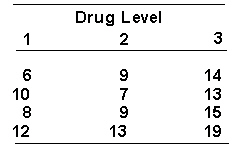 Estimate the size of the effect.
Estimate the size of the effect.  = _________.
= _________.
A) 0.5109
B) 0.5210
C) 0.5100
D) 0.4328
 Estimate the size of the effect.
Estimate the size of the effect.  = _________.
= _________.A) 0.5109
B) 0.5210
C) 0.5100
D) 0.4328

فتح الحزمة
افتح القفل للوصول البطاقات البالغ عددها 218 في هذه المجموعة.
فتح الحزمة
k this deck
38
An investigator conducts an experiment involving the effects of three levels of a drug on memory. Subjects are randomly assigned to one of three conditions. A different drug level is administered in each condition. Memory is measured 10 minutes after each subject receives the drug. The following scores are recorded. The higher the score, the better the memory. 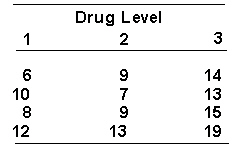 Using a = 0.05, F crit = _________.
Using a = 0.05, F crit = _________.
A) 8.02
B) 4.26
C) 19.38
D) 4.46
 Using a = 0.05, F crit = _________.
Using a = 0.05, F crit = _________.A) 8.02
B) 4.26
C) 19.38
D) 4.46

فتح الحزمة
افتح القفل للوصول البطاقات البالغ عددها 218 في هذه المجموعة.
فتح الحزمة
k this deck
39
An investigator conducts an experiment involving the effects of three levels of a drug on memory. Subjects are randomly assigned to one of three conditions. A different drug level is administered in each condition. Memory is measured 10 minutes after each subject receives the drug. The following scores are recorded. The higher the score, the better the memory. 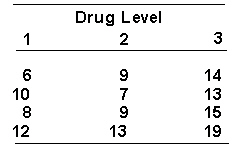 Estimate the size of the effect. 2 = __________.
Estimate the size of the effect. 2 = __________.
A) 0.6524
B) 0.6176
C) 0.6318
D) 0.6034
 Estimate the size of the effect. 2 = __________.
Estimate the size of the effect. 2 = __________.A) 0.6524
B) 0.6176
C) 0.6318
D) 0.6034

فتح الحزمة
افتح القفل للوصول البطاقات البالغ عددها 218 في هذه المجموعة.
فتح الحزمة
k this deck
40
What is the value of F crit ? Use a = 0.05. 
A) 5.14
B) 4.76
C) 4.46
D) 4.07

A) 5.14
B) 4.76
C) 4.46
D) 4.07

فتح الحزمة
افتح القفل للوصول البطاقات البالغ عددها 218 في هذه المجموعة.
فتح الحزمة
k this deck
41
The HSD test _________.
A) is used for planned comparisons
B) maintains the Type I error rate at alpha
C) is used for a post hoc comparisons
D) maintains the Type I error rate at alpha and is used for a post hoc comparisons
A) is used for planned comparisons
B) maintains the Type I error rate at alpha
C) is used for a post hoc comparisons
D) maintains the Type I error rate at alpha and is used for a post hoc comparisons

فتح الحزمة
افتح القفل للوصول البطاقات البالغ عددها 218 في هذه المجموعة.
فتح الحزمة
k this deck
42
If s 12 = 10, s 22 = 15, and s 32 = 12, and n 1 = n 2 = n 3 , then MSwithin equals _________.
A) cannot be determined from information given
B) 37.0
C) 12.33
D) 3.51
A) cannot be determined from information given
B) 37.0
C) 12.33
D) 3.51

فتح الحزمة
افتح القفل للوصول البطاقات البالغ عددها 218 في هذه المجموعة.
فتح الحزمة
k this deck
43
If = 46, = 50, = 92 and n 1 = n 2 = n 3 , what is the value of ?
A) cannot be determined from information given
B) 50.0
C) 188.0
D) 62.67
A) cannot be determined from information given
B) 50.0
C) 188.0
D) 62.67

فتح الحزمة
افتح القفل للوصول البطاقات البالغ عددها 218 في هذه المجموعة.
فتح الحزمة
k this deck
44
Using 2, what is the estimated size of effect? 
A) 0.7232
B) 0.6852
C) 0.6582
D) 0.6312

A) 0.7232
B) 0.6852
C) 0.6582
D) 0.6312

فتح الحزمة
افتح القفل للوصول البطاقات البالغ عددها 218 في هذه المجموعة.
فتح الحزمة
k this deck
45
If s 12 = 9, s 22 = 6, s 32 = 8, and n 1 ≠ n 2 ≠ n 3 , then MSwithin equals _________.
A) cannot be determined from information given
B) 7.667
C) 2.77
D) 23.0
A) cannot be determined from information given
B) 7.667
C) 2.77
D) 23.0

فتح الحزمة
افتح القفل للوصول البطاقات البالغ عددها 218 في هذه المجموعة.
فتح الحزمة
k this deck
46
Which of the following is(are) statistical test(s) for doing post hoc comparisons?
A) HSD test
B) Scheffé test
C) independent t test
D) two group one-way ANOVA
E) HSD test and independent t test
A) HSD test
B) Scheffé test
C) independent t test
D) two group one-way ANOVA
E) HSD test and independent t test

فتح الحزمة
افتح القفل للوصول البطاقات البالغ عددها 218 في هذه المجموعة.
فتح الحزمة
k this deck
47
A posteriori or post hoc comparisons _________.
A) are planned before the experiment
B) are often decided on after the data are collected
C) require a significant F obt before they may be conducted
D) are often decided on after the data are collected and require a significant F obt before they may be conducted
E) all of these
A) are planned before the experiment
B) are often decided on after the data are collected
C) require a significant F obt before they may be conducted
D) are often decided on after the data are collected and require a significant F obt before they may be conducted
E) all of these

فتح الحزمة
افتح القفل للوصول البطاقات البالغ عددها 218 في هذه المجموعة.
فتح الحزمة
k this deck
48
Using the HSD test, if there are 16 df associated with MSwithin , and a = .05 and the number of groups = 3, Q crit = _________.
A) 4.13
B) 3.00
C) 3.65
D) 4.79
A) 4.13
B) 3.00
C) 3.65
D) 4.79

فتح الحزمة
افتح القفل للوصول البطاقات البالغ عددها 218 في هذه المجموعة.
فتح الحزمة
k this deck
49
Using  , the estimated size of effect is _________.
, the estimated size of effect is _________. 
A) 22.6% of the variability
B) 52.8% of the variability
C) 43.6% of the variability
D) 55.1% of the variability
 , the estimated size of effect is _________.
, the estimated size of effect is _________. 
A) 22.6% of the variability
B) 52.8% of the variability
C) 43.6% of the variability
D) 55.1% of the variability

فتح الحزمة
افتح القفل للوصول البطاقات البالغ عددها 218 في هذه المجموعة.
فتح الحزمة
k this deck
50
If MSbetween = 27.9 and MSwithin = 54.2, what is the value of F obt?
A) impossible result, there must be an error
B) 1.94
C) 0.51
D) 2.76
A) impossible result, there must be an error
B) 1.94
C) 0.51
D) 2.76

فتح الحزمة
افتح القفل للوصول البطاقات البالغ عددها 218 في هذه المجموعة.
فتح الحزمة
k this deck
51
What is the value of ΣStotal if ΣSbetween = 236 and ΣSwithin = 54?
A) 290
B) 182
C) 4.37
D) 100
A) 290
B) 182
C) 4.37
D) 100

فتح الحزمة
افتح القفل للوصول البطاقات البالغ عددها 218 في هذه المجموعة.
فتح الحزمة
k this deck
52
In doing planned comparisons, we use _________.
A) the t test for independent groups, unaltered
B) the t test for independent groups with MSwithin in the denominator
C) df equal to those of MSwithin
D) the t test for independent groups with MSwithin in the denominator and df equal to those of MSwithin
A) the t test for independent groups, unaltered
B) the t test for independent groups with MSwithin in the denominator
C) df equal to those of MSwithin
D) the t test for independent groups with MSwithin in the denominator and df equal to those of MSwithin

فتح الحزمة
افتح القفل للوصول البطاقات البالغ عددها 218 في هذه المجموعة.
فتح الحزمة
k this deck
53
By doing multiple t tests when there are more than 2 experimental groups we increase the risk of making what kind of mistake?
A) accepting H0
B) Type I error
C) Type II error
D) all of these
A) accepting H0
B) Type I error
C) Type II error
D) all of these

فتح الحزمة
افتح القفل للوصول البطاقات البالغ عددها 218 في هذه المجموعة.
فتح الحزمة
k this deck
54
Using the Scheffé test, the appropriate critical value = _________.
A) F crit taken from the entire ANOVA
B) F crit taken from the 2 groups being compared
C) t crit using the df taken from the entire ANOVA
D) t crit using the df taken from the 2 groups being compared
A) F crit taken from the entire ANOVA
B) F crit taken from the 2 groups being compared
C) t crit using the df taken from the entire ANOVA
D) t crit using the df taken from the 2 groups being compared

فتح الحزمة
افتح القفل للوصول البطاقات البالغ عددها 218 في هذه المجموعة.
فتح الحزمة
k this deck
55
If df between = 3 and df total = 29 and F obt = 3.15, what would you conclude using a = 0.05?
A) reject H0
B) reject H1
C) retain H0
D) retain H1
A) reject H0
B) reject H1
C) retain H0
D) retain H1

فتح الحزمة
افتح القفل للوصول البطاقات البالغ عددها 218 في هذه المجموعة.
فتح الحزمة
k this deck
56
If SSwithin = 126, N = 28, k = 4, then what is the value of MSwithin ?
A) cannot be determined from information given
B) 5.25
C) 42.0
D) 4.667
A) cannot be determined from information given
B) 5.25
C) 42.0
D) 4.667

فتح الحزمة
افتح القفل للوصول البطاقات البالغ عددها 218 في هذه المجموعة.
فتح الحزمة
k this deck
57
If k = 2 and t obt = 2.95, what would the value of F obt be for an independent groups design?
A) 2.95
B) 8.70
C) 1.72
D) 0.05
A) 2.95
B) 8.70
C) 1.72
D) 0.05

فتح الحزمة
افتح القفل للوصول البطاقات البالغ عددها 218 في هذه المجموعة.
فتح الحزمة
k this deck
58
A priori comparisons _________.
A) are planned in advance of the experiment
B) often arise out of theory and prior research
C) may be done without obtaining a significant F obt in the one-way ANOVA
D) all of these
A) are planned in advance of the experiment
B) often arise out of theory and prior research
C) may be done without obtaining a significant F obt in the one-way ANOVA
D) all of these

فتح الحزمة
افتح القفل للوصول البطاقات البالغ عددها 218 في هذه المجموعة.
فتح الحزمة
k this deck
59
If SStotal = 96, SSwithin = 47, and SS between = 68, what would you conclude?
A) reject H0
B) retain H0
C) cannot be determined from information given
D) there must be an error in the calculations
A) reject H0
B) retain H0
C) cannot be determined from information given
D) there must be an error in the calculations

فتح الحزمة
افتح القفل للوصول البطاقات البالغ عددها 218 في هذه المجموعة.
فتح الحزمة
k this deck
60
When doing planned comparisons, _________.
A) there is no correction for the inflated Type I error probability
B) a different number of df are used which corrects for the inflated Type I error probability
C) t obt is reduced to correct for the inflated Type I error probability
D) a different sampling distribution is used to correct for the inflated Type I error probability
A) there is no correction for the inflated Type I error probability
B) a different number of df are used which corrects for the inflated Type I error probability
C) t obt is reduced to correct for the inflated Type I error probability
D) a different sampling distribution is used to correct for the inflated Type I error probability

فتح الحزمة
افتح القفل للوصول البطاقات البالغ عددها 218 في هذه المجموعة.
فتح الحزمة
k this deck
61
An investigator conducts an experiment involving the effects of three levels of a drug on memory. Subjects are randomly assigned to one of three conditions. A different drug level is administered in each condition. Memory is measured 10 minutes after each subject receives the drug. The following scores are recorded. The higher the score, the better the memory. 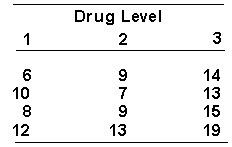 Using a = .05, what do you conclude?
Using a = .05, what do you conclude?
A) retain H 0 ; we cannot conclude the drug has a different effect at these levels
B) reject H 0 ; the drug has different effects at these levels
C) retain H 0 ; the drug has the same effect at these levels
D) reject H 0 ; the groups are not significantly different
 Using a = .05, what do you conclude?
Using a = .05, what do you conclude?A) retain H 0 ; we cannot conclude the drug has a different effect at these levels
B) reject H 0 ; the drug has different effects at these levels
C) retain H 0 ; the drug has the same effect at these levels
D) reject H 0 ; the groups are not significantly different

فتح الحزمة
افتح القفل للوصول البطاقات البالغ عددها 218 في هذه المجموعة.
فتح الحزمة
k this deck
62
An investigator conducts an experiment involving the effects of three levels of a drug on memory. Subjects are randomly assigned to one of three conditions. A different drug level is administered in each condition. Memory is measured 10 minutes after each subject receives the drug. The following scores are recorded. The higher the score, the better the memory. 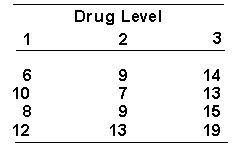 Assume you are doing planned comparisons, using a = .05. The critical value is _________.
Assume you are doing planned comparisons, using a = .05. The critical value is _________.
A) ± 2.262
B) - 1.833
C) ±2.228
D) 3.95
E) 3.20
 Assume you are doing planned comparisons, using a = .05. The critical value is _________.
Assume you are doing planned comparisons, using a = .05. The critical value is _________.A) ± 2.262
B) - 1.833
C) ±2.228
D) 3.95
E) 3.20

فتح الحزمة
افتح القفل للوصول البطاقات البالغ عددها 218 في هذه المجموعة.
فتح الحزمة
k this deck
63
A clinical psychologist is interested in comparing the effectiveness of short term relaxation and cognitive-behavioral therapy in treating mild depression. An experiment is conducted in which 15 patients with mild depression are randomly selected and assigned 5 each to a relaxation therapy group, a cognitive/behavioral therapy group, and an attention placebo group. Therapy is administered until the patient is judged no longer depressed or until 10 treatment sessions have elapsed. The following data is obtained. Scores are the number of sessions for each patient.  Doing planned comparisons, using a = 0.05, the critical value is _________.
Doing planned comparisons, using a = 0.05, the critical value is _________.
A) ± 2.179
B) - 1.782
C) ±2.681
D) 2.145
 Doing planned comparisons, using a = 0.05, the critical value is _________.
Doing planned comparisons, using a = 0.05, the critical value is _________.A) ± 2.179
B) - 1.782
C) ±2.681
D) 2.145

فتح الحزمة
افتح القفل للوصول البطاقات البالغ عددها 218 في هذه المجموعة.
فتح الحزمة
k this deck
64
An investigator conducts an experiment involving the effects of three levels of a drug on memory. Subjects are randomly assigned to one of three conditions. A different drug level is administered in each condition. Memory is measured 10 minutes after each subject receives the drug. The following scores are recorded. The higher the score, the better the memory. 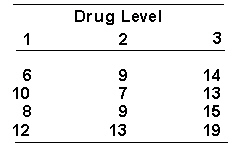 Assume you are doing planned comparisons evaluating drug levels 2 and 3 using a = 0.05 and H 1 is nondirectional. What is your conclusion?
Assume you are doing planned comparisons evaluating drug levels 2 and 3 using a = 0.05 and H 1 is nondirectional. What is your conclusion?
A) accept H 0 ; the drug has the same effect at these levels
B) retain H 0 ; we cannot conclude the drug has a different effect at these levels
C) reject H 0 ; the groups are not significantly different
D) reject H 0 ; the drug has different effects at these levels
 Assume you are doing planned comparisons evaluating drug levels 2 and 3 using a = 0.05 and H 1 is nondirectional. What is your conclusion?
Assume you are doing planned comparisons evaluating drug levels 2 and 3 using a = 0.05 and H 1 is nondirectional. What is your conclusion?A) accept H 0 ; the drug has the same effect at these levels
B) retain H 0 ; we cannot conclude the drug has a different effect at these levels
C) reject H 0 ; the groups are not significantly different
D) reject H 0 ; the drug has different effects at these levels

فتح الحزمة
افتح القفل للوصول البطاقات البالغ عددها 218 في هذه المجموعة.
فتح الحزمة
k this deck
65
An investigator conducts an experiment involving the effects of three levels of a drug on memory. Subjects are randomly assigned to one of three conditions. A different drug level is administered in each condition. Memory is measured 10 minutes after each subject receives the drug. The following scores are recorded. The higher the score, the better the memory.  Assume you are doing post hoc testing between drug levels 2 and 3 using the Scheff test. Given the following values obtained from the ANOVA:
Assume you are doing post hoc testing between drug levels 2 and 3 using the Scheff test. Given the following values obtained from the ANOVA:  ,
,  ,
,  , n 1 = n 2 = n 3 = 4, k = 3, df between = 2, df within = 9, MSwithin = 6.639, the value of SS between ( groups i and j) = _________.
, n 1 = n 2 = n 3 = 4, k = 3, df between = 2, df within = 9, MSwithin = 6.639, the value of SS between ( groups i and j) = _________.
A) 78.125
B) 66.125
C) 0.5000
D) 69.125
 Assume you are doing post hoc testing between drug levels 2 and 3 using the Scheff test. Given the following values obtained from the ANOVA:
Assume you are doing post hoc testing between drug levels 2 and 3 using the Scheff test. Given the following values obtained from the ANOVA:  ,
,  ,
,  , n 1 = n 2 = n 3 = 4, k = 3, df between = 2, df within = 9, MSwithin = 6.639, the value of SS between ( groups i and j) = _________.
, n 1 = n 2 = n 3 = 4, k = 3, df between = 2, df within = 9, MSwithin = 6.639, the value of SS between ( groups i and j) = _________.A) 78.125
B) 66.125
C) 0.5000
D) 69.125

فتح الحزمة
افتح القفل للوصول البطاقات البالغ عددها 218 في هذه المجموعة.
فتح الحزمة
k this deck
66
An investigator conducts an experiment involving the effects of three levels of a drug on memory. Subjects are randomly assigned to one of three conditions. A different drug level is administered in each condition. Memory is measured 10 minutes after each subject receives the drug. The following scores are recorded. The higher the score, the better the memory.  The value of F Scheff is _________.
The value of F Scheff is _________.
A) 5.88
B) 5.21
C) 4.98
D) 0.04
 The value of F Scheff is _________.
The value of F Scheff is _________.A) 5.88
B) 5.21
C) 4.98
D) 0.04

فتح الحزمة
افتح القفل للوصول البطاقات البالغ عددها 218 في هذه المجموعة.
فتح الحزمة
k this deck
67
Doing multiple comparisons following a three group ANOVA with equal n in each group, the critical value of the inference test statistic changes from comparison-to-comparison in the _________.
A) t test for independent groups
B) HSD test
C) Scheffé test
D) all of these
E) none of thse
A) t test for independent groups
B) HSD test
C) Scheffé test
D) all of these
E) none of thse

فتح الحزمة
افتح القفل للوصول البطاقات البالغ عددها 218 في هذه المجموعة.
فتح الحزمة
k this deck
68
A clinical psychologist is interested in comparing the effectiveness of short term relaxation and cognitive-behavioral therapy in treating mild depression. An experiment is conducted in which 15 patients with mild depression are randomly selected and assigned 5 each to a relaxation therapy group, a cognitive/behavioral therapy group, and an attention placebo group. Therapy is administered until the patient is judged no longer depressed or until 10 treatment sessions have elapsed. The following data is obtained. Scores are the number of sessions for each patient.  Using the HSD test with a = 0.05, the appropriate critical value is _________.
Using the HSD test with a = 0.05, the appropriate critical value is _________.
A) ±2.179
B) 3.08
C) 3.77
D) 5.05
 Using the HSD test with a = 0.05, the appropriate critical value is _________.
Using the HSD test with a = 0.05, the appropriate critical value is _________.A) ±2.179
B) 3.08
C) 3.77
D) 5.05

فتح الحزمة
افتح القفل للوصول البطاقات البالغ عددها 218 في هذه المجموعة.
فتح الحزمة
k this deck
69
The value used in the Scheffé test to evaluate is _________.
A) the df computed on groups i and j
B) MSwithin taken from the entire ANOVA
C) the df computed in planned comparisons
D) MSwithin ( groups i and j )
A) the df computed on groups i and j
B) MSwithin taken from the entire ANOVA
C) the df computed in planned comparisons
D) MSwithin ( groups i and j )

فتح الحزمة
افتح القفل للوصول البطاقات البالغ عددها 218 في هذه المجموعة.
فتح الحزمة
k this deck
70
An investigator conducts an experiment involving the effects of three levels of a drug on memory. Subjects are randomly assigned to one of three conditions. A different drug level is administered in each condition. Memory is measured 10 minutes after each subject receives the drug. The following scores are recorded. The higher the score, the better the memory. 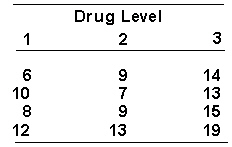 Using the Scheff test with a = 0.05, F crit = _________.
Using the Scheff test with a = 0.05, F crit = _________.
A) 6.99
B) 3.86
C) 8.02
D) 4.26
 Using the Scheff test with a = 0.05, F crit = _________.
Using the Scheff test with a = 0.05, F crit = _________.A) 6.99
B) 3.86
C) 8.02
D) 4.26

فتح الحزمة
افتح القفل للوصول البطاقات البالغ عددها 218 في هذه المجموعة.
فتح الحزمة
k this deck
71
An investigator conducts an experiment involving the effects of three levels of a drug on memory. Subjects are randomly assigned to one of three conditions. A different drug level is administered in each condition. Memory is measured 10 minutes after each subject receives the drug. The following scores are recorded. The higher the score, the better the memory. 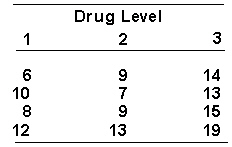 The value of MS between ( groups i and j) = _________.
The value of MS between ( groups i and j) = _________.
A) 33.063
B) 39.062
C) 34.562
D) 0.2500
 The value of MS between ( groups i and j) = _________.
The value of MS between ( groups i and j) = _________.A) 33.063
B) 39.062
C) 34.562
D) 0.2500

فتح الحزمة
افتح القفل للوصول البطاقات البالغ عددها 218 في هذه المجموعة.
فتح الحزمة
k this deck
72
The df used in the Scheffé test to compute is _________.
A) the df computed on the two groups being compared
B) the df between taken from the entire ANOVA
C) the df computed in planned comparisons
D) the df within taken from the entire ANOVA
E) the df computed in planned comparisons and the df within taken from the entire ANOVA
A) the df computed on the two groups being compared
B) the df between taken from the entire ANOVA
C) the df computed in planned comparisons
D) the df within taken from the entire ANOVA
E) the df computed in planned comparisons and the df within taken from the entire ANOVA

فتح الحزمة
افتح القفل للوصول البطاقات البالغ عددها 218 في هذه المجموعة.
فتح الحزمة
k this deck
73
An investigator conducts an experiment involving the effects of three levels of a drug on memory. Subjects are randomly assigned to one of three conditions. A different drug level is administered in each condition. Memory is measured 10 minutes after each subject receives the drug. The following scores are recorded. The higher the score, the better the memory. 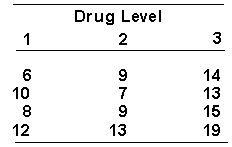 Assume you wanted to compare drug levels 2 and 3 using planned comparisons and a nondirectional H 1 . Given
Assume you wanted to compare drug levels 2 and 3 using planned comparisons and a nondirectional H 1 . Given  ,
,  ,
,  , n = 4, MSwithin = 6.639, df within = 9, df between = 2, k = 3, the obtained value of the appropriate statistic is _________.
, n = 4, MSwithin = 6.639, df within = 9, df between = 2, k = 3, the obtained value of the appropriate statistic is _________.
A) Q obt = 4.46
B) t obt = -3.16
C) t obt = -3.15
D) t obt = -0.55
 Assume you wanted to compare drug levels 2 and 3 using planned comparisons and a nondirectional H 1 . Given
Assume you wanted to compare drug levels 2 and 3 using planned comparisons and a nondirectional H 1 . Given  ,
,  ,
,  , n = 4, MSwithin = 6.639, df within = 9, df between = 2, k = 3, the obtained value of the appropriate statistic is _________.
, n = 4, MSwithin = 6.639, df within = 9, df between = 2, k = 3, the obtained value of the appropriate statistic is _________.A) Q obt = 4.46
B) t obt = -3.16
C) t obt = -3.15
D) t obt = -0.55

فتح الحزمة
افتح القفل للوصول البطاقات البالغ عددها 218 في هذه المجموعة.
فتح الحزمة
k this deck
74
A clinical psychologist is interested in comparing the effectiveness of short term relaxation and cognitive-behavioral therapy in treating mild depression. An experiment is conducted in which 15 patients with mild depression are randomly selected and assigned 5 each to a relaxation therapy group, a cognitive/behavioral therapy group, and an attention placebo group. Therapy is administered until the patient is judged no longer depressed or until 10 treatment sessions have elapsed. The following data is obtained. Scores are the number of sessions for each patient.  Assume you wanted to compare cognitive/behavioral therapy with relaxation therapy, using planned comparisons and a nondirectional H 1 . The obtained value of the appropriate statistic is _________.
Assume you wanted to compare cognitive/behavioral therapy with relaxation therapy, using planned comparisons and a nondirectional H 1 . The obtained value of the appropriate statistic is _________.
A) Q obt = 3.15
B) t obt= -2.29
C) t obt = -2.22
D) t obt = -0.55
 Assume you wanted to compare cognitive/behavioral therapy with relaxation therapy, using planned comparisons and a nondirectional H 1 . The obtained value of the appropriate statistic is _________.
Assume you wanted to compare cognitive/behavioral therapy with relaxation therapy, using planned comparisons and a nondirectional H 1 . The obtained value of the appropriate statistic is _________.A) Q obt = 3.15
B) t obt= -2.29
C) t obt = -2.22
D) t obt = -0.55

فتح الحزمة
افتح القفل للوصول البطاقات البالغ عددها 218 في هذه المجموعة.
فتح الحزمة
k this deck
75
A clinical psychologist is interested in comparing the effectiveness of short term relaxation and cognitive-behavioral therapy in treating mild depression. An experiment is conducted in which 15 patients with mild depression are randomly selected and assigned 5 each to a relaxation therapy group, a cognitive/behavioral therapy group, and an attention placebo group. Therapy is administered until the patient is judged no longer depressed or until 10 treatment sessions have elapsed. The following data is obtained. Scores are the number of sessions for each patient.  Assume you are doing post hoc testing between cognitive behavioral therapy and relaxation therapy, using the Scheffé test. Given the following values obtained from the ANOVA: , , , n 1 = n 2 = n 3 = 5, k = 3, df between = 2, df within = 12, MSwithin = 1.900, the value of SS between ( groups i and j) = _________.
Assume you are doing post hoc testing between cognitive behavioral therapy and relaxation therapy, using the Scheffé test. Given the following values obtained from the ANOVA: , , , n 1 = n 2 = n 3 = 5, k = 3, df between = 2, df within = 12, MSwithin = 1.900, the value of SS between ( groups i and j) = _________.
A) 25.600
B) 173.333
C) 3.600
D) 10.000
 Assume you are doing post hoc testing between cognitive behavioral therapy and relaxation therapy, using the Scheffé test. Given the following values obtained from the ANOVA: , , , n 1 = n 2 = n 3 = 5, k = 3, df between = 2, df within = 12, MSwithin = 1.900, the value of SS between ( groups i and j) = _________.
Assume you are doing post hoc testing between cognitive behavioral therapy and relaxation therapy, using the Scheffé test. Given the following values obtained from the ANOVA: , , , n 1 = n 2 = n 3 = 5, k = 3, df between = 2, df within = 12, MSwithin = 1.900, the value of SS between ( groups i and j) = _________.A) 25.600
B) 173.333
C) 3.600
D) 10.000

فتح الحزمة
افتح القفل للوصول البطاقات البالغ عددها 218 في هذه المجموعة.
فتح الحزمة
k this deck
76
A clinical psychologist is interested in comparing the effectiveness of short term relaxation and cognitive-behavioral therapy in treating mild depression. An experiment is conducted in which 15 patients with mild depression are randomly selected and assigned 5 each to a relaxation therapy group, a cognitive/behavioral therapy group, and an attention placebo group. Therapy is administered until the patient is judged no longer depressed or until 10 treatment sessions have elapsed. The following data is obtained. Scores are the number of sessions for each patient.  Using the HSD test with a = .05, what is your conclusion?
Using the HSD test with a = .05, what is your conclusion?
A) retain H 0 ; we cannot conclude the two therapies differ in effectiveness
B) reject H 0 ; the two therapies appear to differ in effectiveness
C) retain H 0 ; the two therapies have the same effectiveness
D) reject H 0 ; the two therapies are not significantly different
 Using the HSD test with a = .05, what is your conclusion?
Using the HSD test with a = .05, what is your conclusion?A) retain H 0 ; we cannot conclude the two therapies differ in effectiveness
B) reject H 0 ; the two therapies appear to differ in effectiveness
C) retain H 0 ; the two therapies have the same effectiveness
D) reject H 0 ; the two therapies are not significantly different

فتح الحزمة
افتح القفل للوصول البطاقات البالغ عددها 218 في هذه المجموعة.
فتح الحزمة
k this deck
77
A clinical psychologist is interested in comparing the effectiveness of short term relaxation and cognitive-behavioral therapy in treating mild depression. An experiment is conducted in which 15 patients with mild depression are randomly selected and assigned 5 each to a relaxation therapy group, a cognitive/behavioral therapy group, and an attention placebo group. Therapy is administered until the patient is judged no longer depressed or until 10 treatment sessions have elapsed. The following data is obtained. Scores are the number of sessions for each patient.  Doing planned comparisons, using a = 0.05, what is your conclusion?
Doing planned comparisons, using a = 0.05, what is your conclusion?
A) accept H 0 ; the two therapies are equal in effectiveness
B) retain H 0 ; we cannot conclude the two therapies differ in effectiveness
C) reject H 0 ; the groups are not significantly different
D) reject H 0 ; the two therapies appear to be differentially effective
 Doing planned comparisons, using a = 0.05, what is your conclusion?
Doing planned comparisons, using a = 0.05, what is your conclusion?A) accept H 0 ; the two therapies are equal in effectiveness
B) retain H 0 ; we cannot conclude the two therapies differ in effectiveness
C) reject H 0 ; the groups are not significantly different
D) reject H 0 ; the two therapies appear to be differentially effective

فتح الحزمة
افتح القفل للوصول البطاقات البالغ عددها 218 في هذه المجموعة.
فتح الحزمة
k this deck
78
An investigator conducts an experiment involving the effects of three levels of a drug on memory. Subjects are randomly assigned to one of three conditions. A different drug level is administered in each condition. Memory is measured 10 minutes after each subject receives the drug. The following scores are recorded. The higher the score, the better the memory.  The appropriate df for doing planned comparisons = _________.
The appropriate df for doing planned comparisons = _________.
A) 11
B) 6
C) 9
D) 2
 The appropriate df for doing planned comparisons = _________.
The appropriate df for doing planned comparisons = _________.A) 11
B) 6
C) 9
D) 2

فتح الحزمة
افتح القفل للوصول البطاقات البالغ عددها 218 في هذه المجموعة.
فتح الحزمة
k this deck
79
A clinical psychologist is interested in comparing the effectiveness of short term relaxation and cognitive-behavioral therapy in treating mild depression. An experiment is conducted in which 15 patients with mild depression are randomly selected and assigned 5 each to a relaxation therapy group, a cognitive/behavioral therapy group, and an attention placebo group. Therapy is administered until the patient is judged no longer depressed or until 10 treatment sessions have elapsed. The following data is obtained. Scores are the number of sessions for each patient.  Assume you are comparing cognitive/behavioral therapy with relaxation therapy, using the HSD test. The obtained value of the appropriate statistic is _________.
Assume you are comparing cognitive/behavioral therapy with relaxation therapy, using the HSD test. The obtained value of the appropriate statistic is _________.
A) t obt = - 2.23
B) Q obt = 3.24
C) Q obt = - 3.15
D) Q obt = 5.25
 Assume you are comparing cognitive/behavioral therapy with relaxation therapy, using the HSD test. The obtained value of the appropriate statistic is _________.
Assume you are comparing cognitive/behavioral therapy with relaxation therapy, using the HSD test. The obtained value of the appropriate statistic is _________.A) t obt = - 2.23
B) Q obt = 3.24
C) Q obt = - 3.15
D) Q obt = 5.25

فتح الحزمة
افتح القفل للوصول البطاقات البالغ عددها 218 في هذه المجموعة.
فتح الحزمة
k this deck
80
When doing multiple comparisons, which method is the most powerful?
A) planned comparisons
B) Scheffé test
C) the HSD test
D) they are all equally powerful
A) planned comparisons
B) Scheffé test
C) the HSD test
D) they are all equally powerful

فتح الحزمة
افتح القفل للوصول البطاقات البالغ عددها 218 في هذه المجموعة.
فتح الحزمة
k this deck








